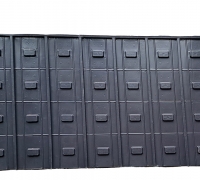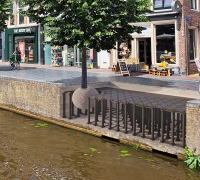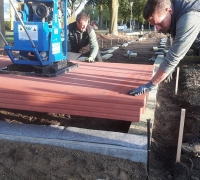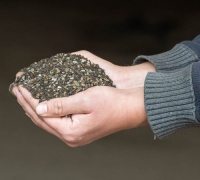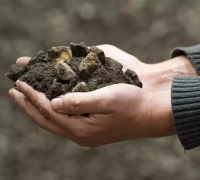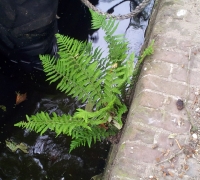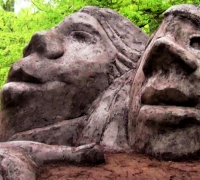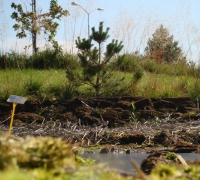

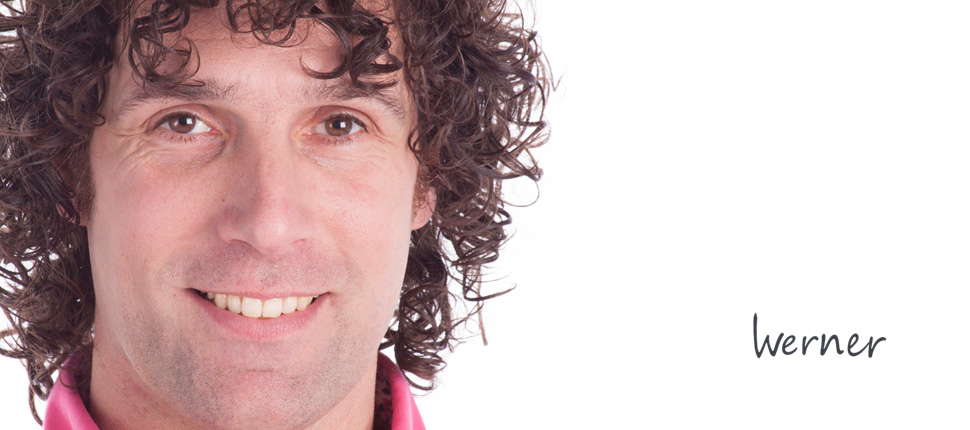

Zoutslot (SaltAway) preventing salty runoff water entering your treepit
nominated for the Vlario innovation award 2023 Belgium
Soon more info on our website
RootGuideRoll with patented new production method 2,5D extrusion
It was Deeproot US the founder of root guide screens that understood quite early on that deeper-rooted roots cause less root upheaval than roots growing high in the profile. The Deeproot panels were developed in the 1990s. Thickness growth of roots increases the volume under soil. The damage caused to the pavement caused by root growth decreases as tree roots grow deeper.
Vertical ribs and horizontal ribs
The vertical ribs are needed to actually guide the roots downwards. The horizontal ribs prevent the screens from being pushed up by the roots guided downwards. Until now, this was only reserved for products manufactured by injection moulding.
Root guide screens on rolls versus panels.
For processing, root guide screens on roll are more effective and faster to process. Each joint is a potential escape route for tree roots. Root guiding screens are therefore also functionally more effective in preventing root encroachment.
2½D extruded root guide screens.
A new and patented production process allows vertical and horizontal ribs to be applied to an infinitely long screen on rolls. A root guidance screen with the advantages of both worlds. The perfect root guide screen. RootGuideRoll
RootBox® is setting the new standard in soil cell systems
The RootBox the second soil cell system designed by Werner Hendriks. Soil cell systems are now well established everywhere. Since the introduction of 4 new soil cells in 2016, it is time again for an upgraded version. The Rootbox combines all the plus points of these products in 1 new system. And in doing so, the product has also been adapted to today's needs; combining rainwater harvesting and root growth under paving; Sponge cities. Werner Hendriks entered into cooperation with a manufacturer of rainwater systems for this very reason. HTW infiltration technology.
Setting a new standard; point load capacity.
Point loads of traffic are not evenly distributed in road foundations without poured concrete, the lids of soil cells are loaded with a point load. But all soil cells are tested with an evenly distributed load, in other words the uprights (legs) are tested but not the lids (decks). The RootBox is the only system tested and approved to withstand these point loads.
With less plastic a higher load capacity.
See more info at www.treerootsystems.nl
Luxilane® ; root upheaval resistance bicycle path
The Netherlands is the country of the free-laying cycle paths (not connected to the mainroad) . But the requirements for these separate cycle paths are also becoming increasingly stringent over the years. It was Swaans beton that saw a market in prefabricated concrete cycle paths that are resistant to root pressure. To develop a product, specialists in the field of tree roots were sought in the market. Rob Verdonschot, commercial director of Swaans beton, came into contact with Werner Hendriks.
2 Luxilane products.
In an intensive collaboration, the idea of a root pressure-resistant cycle path was worked out. And resulted in 2 forms of a floating cycle path. Luxilane on sleepers and Luxilane on pillars. Luxilane has now become a standard in the cycle path world and is now also being laid outside the Netherlands.
Treeparker, the first dutch designed Soil cell system.
In 2014, Green max kicked off the development of a new soil cell system. At that time, it became increasingly clear that the modular soil cell systems had many advantages over the concrete suspended pavement systems. After much research, mainly abroad, and various designs, Werner Hendriks' design concept was finally chosen. The concept was then developed and accommodated in a new joint company.
TreeParker was introduced to the European market during the GaLaBau in 2016, simultaneously with 3 other soil cell systems. The days of using customised infiltration crates, are definitely over. It was clear that tree (infiltration) crates, with many small spaces, were detrimental to water and air management and also the growth of big roots. The four new systems opened many new doors as each system had its own advantages over the others.
Urbansand: the upgrade of Amsterdam treesoil.
Urbansand. Combines the advantages of sand- and gravel based structural soils.
The idea arose during excavation work during the world horticultural expo Floriade 2012 in Venlo. During the work with fine gravel, Werner saw that this compacted gravel could be processed with a shovel. And so the idea of using fine gravel for urbantree planting solution was born.
Sandbased versus Gravelbased
Sandbased structural soil SBSS, also known as Amsterdam treesoil, is a product that has been widely used in the Netherlands. Despite the low load bearing capacity compared to gravel-based structural soils(GBSS) , SBSS also has its own advantages. Underground cables and pipes can be integrated into this sand based load-bearing substrate without additional measures.
In GBSS, crossing utilities must be surrounded by a protective layer, usually a sand layer is used for this purpose. The angular stones in the structural soil damage the pipes as soon as the GBSS is compacted. The damage to the pipes leads to problems over time and the utilities needs to be replaced causing damage to the tree roots.
Urbansand; is an XL SBSS and an XS GBSS
Urbansand combines the load bearing capacity of GBSS and the utility-friendliness of Amsterdam treesoil. Due to the use of a very small crushed stone, it is allowed to use it in direct contact with the utilities. Due to the small parts, the Urbansand can be manually worked even after compaction. A big advantage compared to GBSS, which requires an excavator to process it after compaction.
Kekkilä-BVB landscaping European distributor of Urbansand.
Urbangranulate; maximises soil volume in structural soil
Planting trees in paved area's with structural soil.
Structural soil is a compromise between road construction and tree requirements.
Improving the specifications of one affects the other.
Structural soil is also called a rootable road foundation. it is a mix of stones without the fines. The gaps between the stones are then partly or fully filled with a nutrient-rich soil. The rock is spreading the traffic loads down, and rotos will grow in between the rock particles.
Urbangranulate
Standard ratio in crushed stone : stone versus pore 70 - 30 .
By using a different crushing and screening method, Werner has made it possible to change this ratio to around 60-40. But fewer contact points between the stones means that only hard types of stone can be used to ensure the civil engineering load-bearing capacity. With this pore volume, about 35% soil can be handled between the stones. Quite a saving compared to previous structural soils where only approx. 25% soil was added.
Kekkilä-BVB landscaping European distributor of Urbangranulate.
Accap® Bioreceptive (quay) walls.
The aim : natural, spontaneous planting on newly masonry walls.
Most urban quay walls in the Netherlands were built after the war and are in need of replacement. The increase in traffic load on the quays has made many quay walls unsafe. Some walls have already spontaneously collapsed. The downside of replacing these walls is the disappearance of urban greenery. In fact, rare plants have found their growing place on these walls. When the quay walls are renovated, these rare plants would disappear. The problem is that a new wall only becomes overgrown after about 50 years. In collaboration with Rotterdam municipality and Werner Hendriks, a new solution was developed whereby conditions for the growth of red listed plants are created on the wall after 5-8 years.
BMP ; Best management practice Accap®.
Accap® is applied in the cavity between the structural back wall and the aesthetic stone wall. Accap®' accelerates the conditions in the wall for plant growth.
New company : Groenekade bv
After 10 years of ongoing development within GroeneMorgen, the product and its sales were transferred to a separate company. Groenekade.
Urban River Regeneration through Nature Inclusive Quays
Breda, as many other cities in Europe is struggling with unsustainable urbanisation, degradation of urban ecosystems, and lack of resilience to climate change. Addressing these challenges, GreenQuays aims at sustainable urban renaturation in Breda using nature inclusive regenerative solutions (green quays linked to public green spaces) as part of a bigger scheme targeting the urban restoration of the river Mark.
Sculppeat® modelling with potting soil.
Nothing is more inspiring than working with artists.
The idea for Sculppeat® originated during Floriade 2012. Where renowned artist Sjer Jacobs - the creator of the concept - approached Werner Hendriks to develop the concept into a usable and marketable product. The word explains the entire product itself. This special potting soil can be used to make your own creations in the garden. These creations literally come to life through the planting.
New application of Sculppeat® in the Arabic's.
Greening up eroded steep rock faces. Meanwhile, the product is also used for greening cliffs in the Arabic's The Sculppeat® is then just a small layer applied against the rocks, giving natural plants a base to get started. The plants then use the cracks in the rocks to grow further, creating natural vegetation on the rocks again with the use of Sculppeat®.
Phagnum nursery
First real raised bog (peat) regeneration in the Netherlands.
Only a few small pieces of our vast expanse of raised bogs have survived in the Netherlands. The natural peat fields (peat bogs and raised bogs) in the Netherlands are almost completely destroyed and difficult to restore. Much money has been spent in vain on restoring these destroyed bogs. With little startling results.
Werner connected the missing links together
GROENEMORGEN has linked knowledge from different disciplines in the Netherlands and abroad and, as a result, a system has been created to allow peat to grow again in places outdoors where peat has never grown before. Werner Hendriks: "We are trying to achieve a growth of 5 to 10 cm per year. This is in contrast to the 2 mm growth of a natural bog dome." See photos first results.
